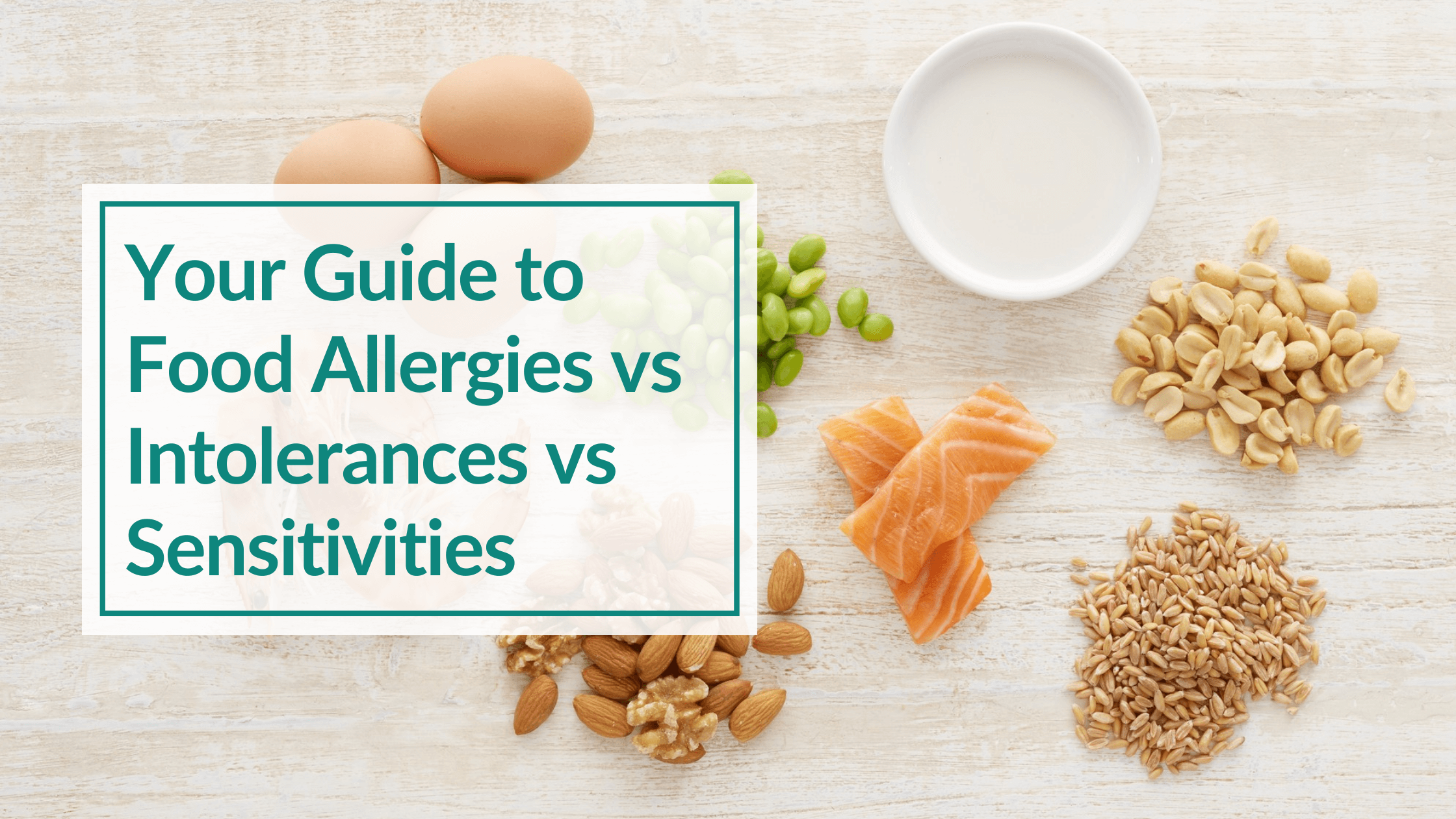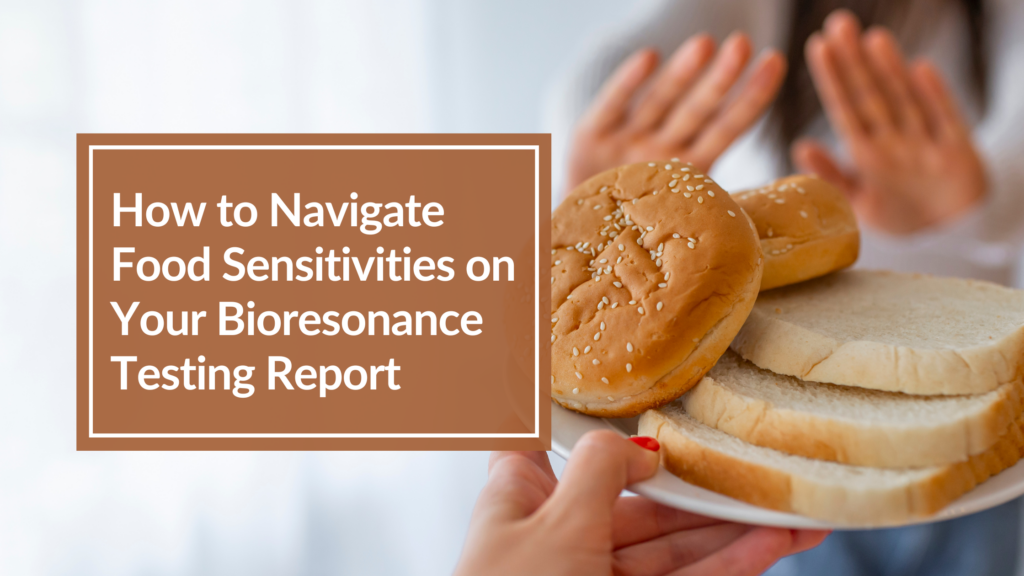
Differentiating Food Allergies vs Intolerances and Also Sensitivities
Navigating food allergies vs intolerances vs sensitivities can feel like a challenge. Is that bloating after breakfast a food allergy or just an intolerance? Is your mid-afternoon headache a result of food sensitivity? What exactly is the difference!?
These terms are often used incorrectly because of their similarities, but they are actually distinct, with different mechanisms and implications. Let’s break it down in this blog and see how understanding these differences can help you navigate the foods you eat and your health like a pro.
Food Allergies
Food allergies are like the body’s overprotective bouncer—they can provoke a swift and sometimes extreme response. When someone with a true food allergy consumes even a tiny amount of the allergen, their Immune system goes on high alert.
When you have a food allergy, your Immune System is involved. It incorrectly identifies a component (usually a protein) in the food as harmful. The Immune System’s job is to protect us from invaders – so that’s essentially what it’s doing! This triggers your body to mount an allergic response to what it perceives as a threat.
Food allergies ALWAYS involve the Immune System. This is the first way to identify the differences between food allergies vs intolerances, or food allergies and sensitivities!
Disclaimer: At CBH, we do not diagnose food allergies.
Types of Food Allergies
There are 2 main categories of food allergies:
- Immunoglobulin E (IgE) mediated. This type involves the body’s Immune System making antibodies called IgE. IgE-mediated food allergies can trigger anaphylaxis and life-threatening allergic reactions.
- Non-IgE-mediated. This type of food allergy involves other parts of the Immune System reacting without the IgE antibody. Non-IgE-mediated allergies are less understood than IgE-mediated ones because their symptoms are usually delayed, making it harder to link the food to the reaction. Many non-IgE reactions are believed to be mediated by T-cells, a type of immune cell that helps direct the body’s response to pathogens and other foreign substances. Issues here are typically less immediate but can still be uncomfortable, typically involving the Digestive System. One example of a non-IgE-mediated food allergy is Food Protein-Induced Enterocolitis Syndrome (FPIES), a condition that primarily affects infants and young children.
You can have both IgE-mediated food allergy and non-IgE-mediated food allergy!
Common Food Allergens
You can be allergic to any food, but some are more common. Here are some of the top offenders:
- Peanuts
- Tree Nuts (such as almonds, walnuts, and cashews)
- Shellfish (including shrimp, crab, and lobster)
- Milk (not lactose intolerance; it’s the protein that’s the issue here)
- Eggs (both the whites and yolks can be problematic)
- Wheat (beyond gluten, the entire protein profile can be the culprit)
The most frequent triggers for non-IgE-mediated food allergies are cow’s milk and soy proteins in infants and wheat in older children.
What Happens in the Body?
When you consume an allergen, specialized immune cells called mast cells and basophils recognize the allergen and release a cocktail of chemicals into the bloodstream.

Histamine plays a big part. It causes blood vessels to dilate and become more permeable, leading to swelling (angioedema), itching, and hives (urticaria). Histamine also acts on nerve endings, causing itching and potentially pain.
Other chemicals can further amplify the inflammatory response, in addition to histamine. This can lead to more severe issues (as mentioned above), such as difficulty breathing, throat tightening (due to swelling), gastrointestinal disturbances, and, in severe cases, anaphylaxis.
Identifying Food Allergies
Unmasking a food allergy often involves skin prick tests or blood tests to detect specific IgE antibodies. These tests help pinpoint which foods trigger allergic reactions.
The go-to conventional treatment for food allergies is strict avoidance of the allergen. This means reading the fine print on every ingredient list, asking questions in restaurants, and potentially having an epinephrine auto-injector (EpiPen) in case of accidental exposure.
Next, we’ll explore food sensitivities and also energetic food sensitivities. We’re peeling back the layers in our guide to food allergies vs intolerances vs sensitivities!
Food Sensitivities
If you Google food sensitivities, you’ll see this term is often interchanged with intolerances. This study on the difference between food allergies vs food intolerance states specifically that: “Food sensitivity is a nonspecific term that can include any symptom perceived to be related to food and thus may be subject to a wide range of usage and interpretation.”
What Happens in the Body?
Sensitivities may involve the Immune System like allergies, but are often a delayed response – which can include joint pain, stomach pain, fatigue, rashes, and brain fog.
Identifying Food Sensitivities
The conventional method for identifying food sensitivities is a blood test to measure for IgG antibodies. Practitioners often encourage elimination diets. The best way to figure out which food or foods are causing the reaction is to remove potential food allergens from the diet for two to four weeks, reintroduce them one at a time, and watch for symptoms.
Energetic Food Sensitivities
At CBH, we use bioenergetic testing to look for food sensitivities.
We look at how your body resonates with over 350 different types of foods and environmental sensitivities. When someone conducts blood work, they are testing for specific antibodies in just the bloodstream, whereas we look body-wide, giving a representation of how the entire body may react to the foods. We have an entire blog just on bioenergetic food sensitivities that you can read!
Disclaimer: At CBH, we do not diagnose food allergies with bioenergetic testing. We CAN help identify foods that may be stressing our energetic field in the digestive system or the whole body.
Some common energetic food sensitivities we see on our scans are often found in food additives!
 Here are a few:
Here are a few:
MSG (Monosodium Glutamate) is a flavor enhancer often added to stock cubes, soup, ramen, gravy, and condiments. It is commonly used in savory foods, particularly in Asian cuisine. While it enhances flavor, some people may experience headaches, worsening asthma, chest pain, nausea, flushing, difficulty breathing, or mood changes.
Red Food Dye is a coloring additive found in breakfast cereals, flavored milk, yogurt, puddings, ice creams, popsicles, frosting, and baked goods. It adds vibrant color to foods and drinks but is often scrutinized for its potential effects on health.
Carrageenan is an additive used to thicken, emulsify, and preserve foods and drinks. It is most commonly used in dairy-free milk, meat products, and yogurt. It can cause inflammation, digestive issues, bloating and IBS.
Food Intolerances
We’ve learned about food allergies and sensitivities, knowing that the Immune System is involved – but what’s the difference between food allergies and food intolerances?
Food intolerances don’t involve the Immune System. Instead, they occur when the body has difficulty digesting certain substances in food, leading to uncomfortable issues.
Understanding the nuances of food allergies vs. intolerances helps you know what to do so you can navigate a wellness plan!
What Exactly Is a Food Intolerance?
There are many possible reasons for food intolerances, which is why it gets confusing! But they all involve the digestive system struggling to process certain foods effectively. Let’s look at some of these reasons!
1. Enzymes. Our bodies naturally produce enzymes that help break down food.
Reasons for enzyme depletion:
- Eating Habits: Consuming food too quickly can overwhelm the digestive process.
- Age: Digestive function tends to decline with age, reducing enzyme production.
- Stress: High-stress levels can impact digestive efficiency and enzyme activity.
- Genetics: Some individuals may inherit enzyme deficiencies, affecting their ability to digest specific foods.
2. Digestive Disorders: Conditions like irritable bowel syndrome (IBS) or celiac disease affect how food is broken down.
3. Leaky Gut Syndrome: This occurs when the small intestine lining becomes damaged, allowing undigested food particles and toxins to enter the bloodstream.
4. Fermentation of Undigested Foods: Bacteria in the gut ferment undigested carbohydrates, producing gas and discomfort.
Some of the enzymes we bioenergetically test for include:
Protease(s): This group of enzymes is collectively known as protease on a Full Scan Report. These enzymes are necessary for breaking down protein and liberating amino acids.
Lipase: Much needed to help fat digestion.
Lactase: The milk sugar lactose needs to be broken down with this enzyme. Many people lack this enzyme, making them sensitive to dairy products with high lactose content.
Pepsin: This enzyme also acts on proteins along with helping the release of Vitamin B12. If you see an imbalance of Vitamin B12 on your report, look at the energetic enzymes section for a pepsin imbalance!
Common Food Intolerances
Some foods are more commonly associated with intolerances. Here are the usual suspects:
- Lactose: Found in dairy products, lactose intolerance occurs when the body doesn’t produce enough lactase enzyme to digest lactose, leading to bloating, gas, and diarrhea.
- Gluten: Present in wheat, barley, and rye, gluten intolerance (or non-celiac gluten sensitivity) can cause symptoms like abdominal pain, bloating, and fatigue.
- Fructose: A natural sugar found in fruits and some vegetables, fructose intolerance can lead to similar digestive issues as lactose intolerance.
- Histamines: Certain foods, such as aged cheeses, smoked meats, and wine, contain high levels of histamines, which can cause headaches, hives, and digestive issues in sensitive individuals. This blog post explains histamines in more detail. Remember – in a food allergy – your body is producing the histamine. In this case, it could be that you are intolerant to the natural histamines that are found in food! There is a difference.
- Sulfites: Commonly used as preservatives in wines, dried fruits, and some processed foods, sulfites can trigger asthma-like symptoms and headaches in sensitive people.
What Happens in the Body?

When you consume a food you’re intolerant to, your digestive system can’t process it properly. This can lead to a buildup of undigested substances in the gut, fermenting and producing gas. The result? Bloating, discomfort, and other gastrointestinal issues. It’s like a traffic jam in your digestive system, causing everything to back up.
For example, the lack of lactase enzyme in lactose intolerance means lactose isn’t broken down and absorbed. Instead, it stays in the gut, where bacteria ferment it, producing gas and leading to symptoms like bloating and diarrhea.
Identifying Food Intolerances
This often involves an elimination diet followed by gradually reintroducing suspected foods to see which ones cause symptoms. This also gives your Digestive System a break, allowing any healing or repair from a leaky gut to occur.
Someone with lactose intolerance might switch to lactose-free dairy products or use lactase enzyme supplements. Those with gluten intolerance may opt for a gluten-free diet. It’s about making the best choice for you to keep your digestive system running smoothly.
Practical Tips for Allergies, Intolerances and Sensitivities
- Consult a Practitioner: Especially if you know you have an allergy or allergic reaction to a food, it’s always important to see your licensed healthcare provider.
- Read Labels Carefully: Always check ingredient lists for potential allergens or irritants. Be vigilant about hidden ingredients that might trigger reactions.
- Ask Questions When Dining Out: Don’t hesitate to ask restaurant staff about ingredients and preparation methods. Many establishments are accommodating and can provide options for those with dietary restrictions.
- Keep a Food Diary: Track what you eat and note any symptoms you experience. This can help identify patterns and pinpoint specific foods that might be causing issues.
- Try an Elimination Diet: If you suspect certain foods are causing problems, an elimination diet can help identify triggers. Remove suspected foods for a few weeks, then reintroduce them one at a time to observe reactions.
- Be Patient and Persistent: Finding the right approach to manage your food reactions can take time. Be patient with yourself and persist in seeking solutions that work for you.
Whether you’re navigating an allergy, managing a sensitivity, or dealing with an intolerance, knowing what’s behind your symptoms can help you make more informed decisions about your diet and lifestyle. They all have their own distinct criteria. One is more obvious, while the others may be more subtle.
Bioenergetic Testing with a Full Scan offers insights into your sensitivities. It can help you understand the state of your digestive enzymes, hydrochloric acid levels, and the presence of any toxins, such as parasites, that may impact your digestive system. Parasites may cause a TH2 imbalance in the Immune System, which may indirectly affect your tolerance to certain foods.
Our process can help you answer the question, “Is it the food itself, or is it something else?”

